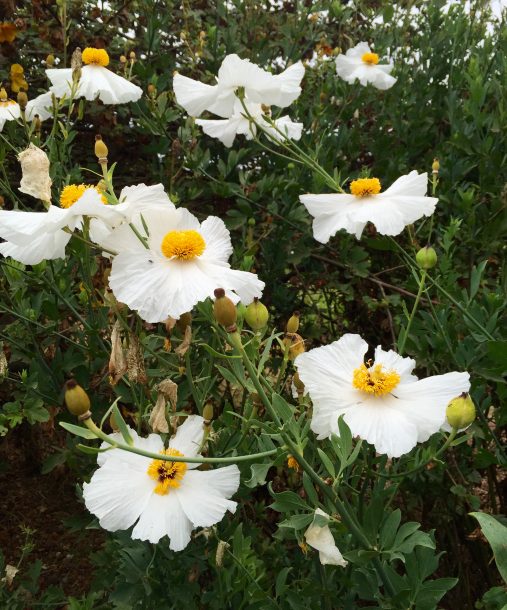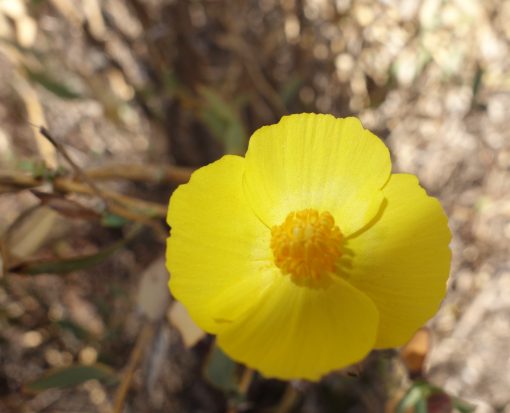
Not long ago I got a call from a home owner with a very bare, vary steep slope behind his house that was in dire need of some kind of erosion control and he needed it pronto. In the rebuild process after the fire the new building pad was created by cutting into an existing slope exposing a steep area with a retaining wall at the bottom. What to do?
I use to recommend Santa Cruz Erosion Mix but that is not the best solution and here’s why. According to the Resource Conservation District of Santa Cruz County, the California Native Plant Society, Weed Management of Santa Cruz County and Santa Cruz County Fish and Wildlife Advisory Commission, the mix contains non-native plants with very weedy attributes including: Blando brome, Hykon Rose Clover and Zorro Fescue. These weeds are rapidly spread by wind, water, animals, humans and equipment and once established are almost impossible to remove.
It’s important when you dealing with erosion issues that whatever you do now will not cause more problems in the future. Sometimes staying off the slope and doing nothing is the best thing to do.
Although native plants are great for long-term erosion control, they can take a few seasons to get established. These two sterile grasses that will germinate in winter, stabilize soil quickly and not become invasive: Common barley (Hordeum vulgare) and Sterile wheat.
Native grasses that grow deep root systems include:
* Meadow barley (Hordeum brachyantherum)
* Blue wild rye (Elymus glaucous)
* Creeping wild rye ( Leymus triticoides)
* Purple needle grass (Stipa pulchra)
* Nodding needle grass (Stipa cernua)
* California brome (Bromus carinatus)
There are many attractive plants that work well for erosion control. Often they need to adapt to shallow, poor soil and cope with less than ideal conditions all while putting down dense, strong roots. California natives are well suited to this job.
Common native shrubs include ceanothus and manzanita of all types. Calycanthus or Spicebush has fragrant flowers in late spring blooming well into summer with a spicy fragrance. The foliage is aromatic when crushed and changes from a spring green color to pale golden in autumn. Decorative woody fruits last into winter making this shrub attractive year round. It thrives with infrequent to moderate watering. Combine with coffeeberry and deer grass in sunnier spots or with Douglas iris and giant chain fern in shaded spots below trees. All these plants have deep roots and control erosion.
Ribes sanguinem or Flowering Currant is another show stopper capable of controlling erosion. In the spring the long, flower clusters of this deciduous shrub will dominate your garden. Choose from white flowering ‘White Icicle’ or ”Barrie Coate” and ‘King Edward VII’ with spectacular deep red flower clusters. ‘Spring Showers’ has 8 inch long pink clusters. Grow in full sun to partial shade. This California native requires little water once established and is a valuable nectar source for hummingbirds.
Some other good California native shrubs for erosion control are western redbud, mountain mahogany, western mock orange, lemonade berry, toyon, matilija poppy and western elderberry. ribes viburnifolium, creeping mahonia and baccharis. Ceanothus maritimus ‘Heart’s Desire’ and ‘Anchor Bay’ are all good ground cover selections and are not attractive to deer.
Symphoricarpos – Common Snowberry or Creeping Snowberry – can hold the soil on steep banks. This native tolerates poor soil, lower light and general neglect.
Smaller natives that put down deep roots are yarrow, coast aster, California fuchsia, wild grape, mimulus, buckwheat, wild rose, sage and salvia.

Bush poppy (dendromecon rigida) is another native found right here in our area and needs no irrigation at all once established. Beautiful bright yellow, poppy-like flowers cover the plant in spring. They can be propagated from cuttings taken in summer and are pest and disease free.
Remember when setting plants on a steep slope to arrange them in staggered rows. Make an individual terrace for each plant and create a basin or low spot behind each one – not around the stem – to catch water. Set the crowns of the plants high so they won’t become saturated and rot after watering and make sure mulch does not build up around the stem.
Fall is the perfect time to plant in our area. The soil is still warm encouraging root growth and the weather is mild. Using the right plants on hillsides can help slow and spread runoff and prevent soil erosion. Mulch also protects soil from direct rain impact and slows runoff across bare soils. Covering the steepest slopes with jute netting through which plants may be installed is an added precaution.
